英语反义疑问句及现在完成时态讲解
反义疑问句一般现在时与一般过去时
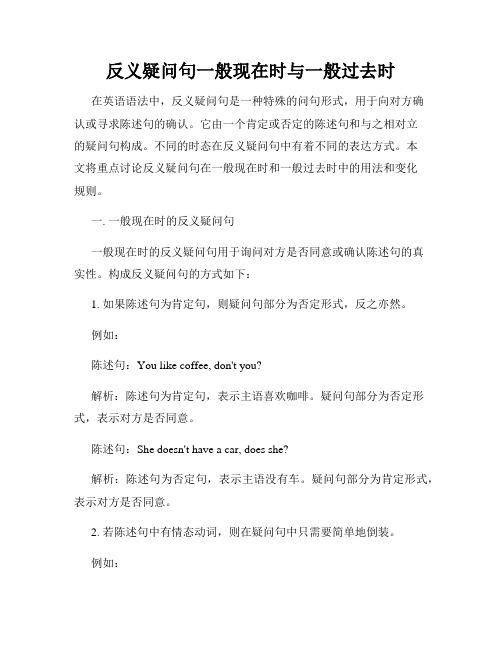
反义疑问句一般现在时与一般过去时在英语语法中,反义疑问句是一种特殊的问句形式,用于向对方确认或寻求陈述句的确认。
它由一个肯定或否定的陈述句和与之相对立的疑问句构成。
不同的时态在反义疑问句中有着不同的表达方式。
本文将重点讨论反义疑问句在一般现在时和一般过去时中的用法和变化规则。
一. 一般现在时的反义疑问句一般现在时的反义疑问句用于询问对方是否同意或确认陈述句的真实性。
构成反义疑问句的方式如下:1. 如果陈述句为肯定句,则疑问句部分为否定形式,反之亦然。
例如:陈述句:You like coffee, don't you?解析:陈述句为肯定句,表示主语喜欢咖啡。
疑问句部分为否定形式,表示对方是否同意。
陈述句:She doesn't have a car, does she?解析:陈述句为否定句,表示主语没有车。
疑问句部分为肯定形式,表示对方是否同意。
2. 若陈述句中有情态动词,则在疑问句中只需要简单地倒装。
例如:陈述句:He can swim, can't he?解析:陈述句中带有情态动词"can",表示他会游泳。
疑问句部分直接倒装,不需要再进行肯定/否定的转变。
陈述句:They won't come, will they?解析:陈述句中带有情态动词"won't",表示他们不会来。
疑问句部分直接倒装。
二. 一般过去时的反义疑问句一般过去时的反义疑问句用于在陈述句后征求对方的肯定或否定意见。
构成反义疑问句的方式如下:1. 如果陈述句为肯定句,则疑问句部分保持肯定形式。
例如:陈述句:She studied Spanish last year, didn't she?解析:陈述句为肯定句,表示她去年学习了西班牙语。
疑问句部分保持肯定形式。
陈述句:He played football yesterday, didn't he?解析:陈述句为肯定句,表示他昨天踢了足球。
反义疑问句一般讲解

① You are from America, ?②It isn’t very cold today, ?③ Tom was away yesterday, ?④The Greens weren’t at home last night ?⑤ Mary is reading English now, ?⑥Your parents aren’t going to have a party this Sunday,?⑦ The girls were singing when the teacher came in, ? 注意:There be句型① There is an old picture on the wall, ?②There aren’t any children in the room, ?③There wasn’t a telephone call for me, ?④ There were enough people to pick apples, ?二、行为动词的一般现在时的反意疑问句① You often watch TV in the evening, ?②The students don’t study hard, ?③ Mary studies Chinese hard, ?④The boy doesn’t often go to school by bike, ?⑤ The first class begins at eight, ?三、行为动词的一般过去时① You watched TV last night, ?②Jim’s parents didn’t go to Hong Kong last mo nth,?③ The rain stopped, ?④Mr. Clarke didn’t buy a car, ?四、现在完成时的反意疑问句① You have been to Shanghai before, ?②You haven’t been to Shanghai before, ?③ Jack has done his homework, ?④Jack hasn’t done his homework, ?五、含有情态动词的反意疑问句① You can speak French, ?②They can’t understand me, ?③ Ann could swim when she was six, ?④ The students must study hard, ?六、① You have never been to Beijing, ?② Mr. Fat has few friends here, ?③ There is little milk in the bottle, ?④ He could do nothing, ?七、1. I'm working now, ?2. Something is wrong with my radio, ?3. Everyone is here, ?4. No one knows about it, ?5. This is a plane, ?6. These are grapes, ?7. One should be ready to help others, ?8. What you need is more important, ?9. To be a doctor is your dream, ?10. Collecting stamps is your hobby, ?11. I don't think he will come, ?12. You have to water the vegetables every day, ?13. You have a digital camera, ?14. He had some bread for breakfast, ?15. He has a cold, ?16. You have an English-Chinese dictionary, ?17. We had better go to school at once, ?18. We had better not go out now, ?19. You'd better go now, ?20. They had to take the early train, ?21. I think he is right, ?练习:1.The computer is very useful in our life,______it?A. isn’tB. wasn’tC. hasn’tD. doesn’t2.---She didn’t come to school yesterday, did she ?---______, though she was not feeling well.A.No, she didn’tB.No, she didC.Yes, she didn’tD. Yes, she did3.There is little milk in the bottle,______?A.isn’t itB.is itC.isn’t thereD.is there4.He has few friends in the new school,______?A.has heB.is heC.doesn’t heD.did he5.“You’ve never seen dinosaur eggs, have you?”“_______. How I wish to visit the Dinosaur World.”A.Yes, I haveB. No, I haven’tC. Certainly, I haveD. Of course, I haven’t6. Bob likes traveling very much,_____he?A.isn’tB.isC.doesn’tD.does7.Kate’s never seen Chinese film,______?A. hasn’t sheB. has sheC. isn’t sheD. is she8.Few of them hurt themselves in the accident last night,_______?A.don’t theyB.didn’t theyC.did theyD.do they9.-----Linda had nothing for breakfast this morning,______?-----No. She got up too late.A.had sheB.hadn’t sheC.did sheD.didn’t she10. Mr. King has never been to France,______?A.has heB.hasn’t Mr.KingC.hasn’t heD.has Mr. King11.“You never have noodles,_____you?”“No. I only like rice.”A.doB.don’tC.haveD.haven’t12. His sister had a bad cough,_____she?A. wasn’tB.doesn’tC.hadn’tD.didn’t13.An elephant is strong,______it?A.doesn’tB.doesC.isn’tD.is14.The town government set up a new modern hospital for the farmers,_____?A.does itB.doesn’t itC.did itD.didn’t it15.Don’t forget to return the library book,_____?A.will youB.can youC.do youD.are you16.Peter could hardly see the words on the blackboard, _____?A.did heB.couldn’t heC.didn’t heD.could he17.Mary’s brother had a talk at school yesterday afternoon,_______A.had heB.hadn’t heC.did heD.didn’t he18.-----Lucy didn’t come to school, did she ?----________. She was ill in bed.A. No, she didB.Yes, she did.C.No, she didn’t.D.Yes, she didn’t.19.There will be a volleyball match in our school, _______?A.be thereB.is thereC.will thereD.won’t there20.Alice stayed up late last night,_______?A.didn’t herB.didn’t AliceC.did sheD.didn’t she21.---Let’s go and fly kites,_____?----Wonderful!A. will youB.shall weC.don’t youD.do you22.You’ve never seen such a wonderful film before,______?A. haven’t youB.have youC.do youD.don’t you。
英语反义疑问句及现在完成时态讲解
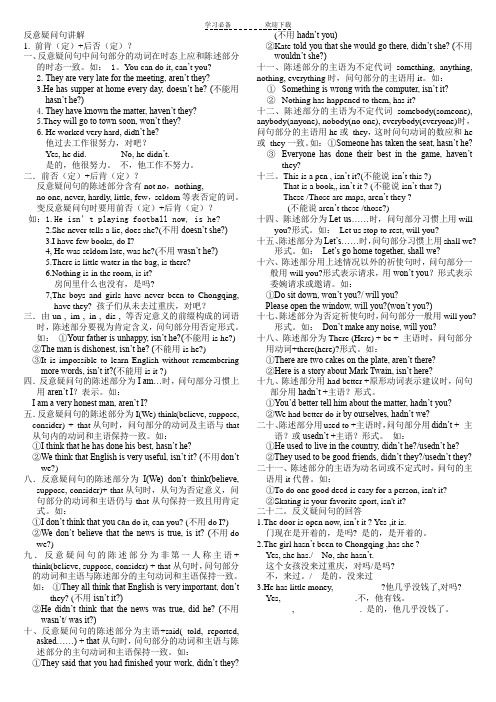
反意疑问句讲解1. 前肯(定)+后否(定)?一、反意疑问句中问句部分的动词在时态上应和陈述部分的时态一致。
如:1。
You can do it, can’t you?2.They are very late for the meeting, aren’t they?3.He has supper at home every day, doesn’t he? (不能用hasn’t he?)4.They have known the matter, haven’t they?5.They wi ll go to town soon, won’t they?6.He worked very hard, did n’t he?他过去工作很努力,对吧?Yes, he did. No, he didn’t.是的,他很努力。
不,他工作不努力。
二.前否(定)+后肯(定)?反意疑问句的陈述部分含有not no,nothing,no one, never, hardly, little, few,seldom等表否定的词。
变反意疑问句时要用前否(定)+后肯(定)?如:1.He isn’t playing football now, is he?2.She never tells a lie, does she?(不用doesn’t she?)3.I have few books, do I?4, He was seldom late, was he?(不用wasn’t he?)5.There is little water in the bag, is there?6.Nothing is in the room, is it?房间里什么也没有,是吗?7,The boys and girls have never been to Chongqing,have they? 孩子们从未去过重庆,对吧?三.由un-, im-, in-, dis-, 等否定意义的前缀构成的词语时,陈述部分要视为肯定含义,问句部分用否定形式。
musthavedone反义疑问句的用法归纳
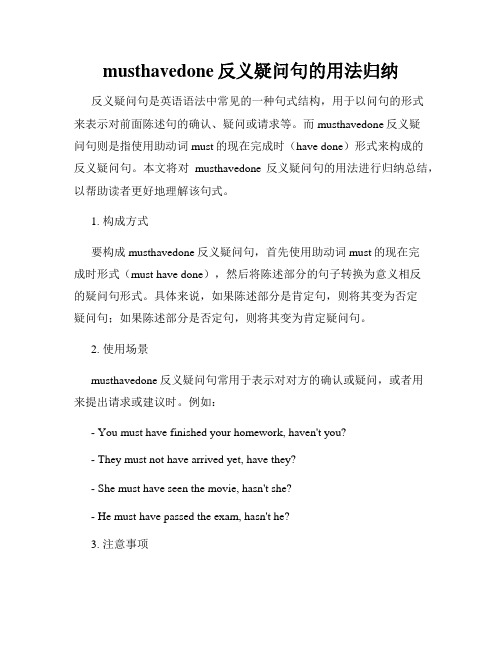
musthavedone反义疑问句的用法归纳反义疑问句是英语语法中常见的一种句式结构,用于以问句的形式来表示对前面陈述句的确认、疑问或请求等。
而musthavedone反义疑问句则是指使用助动词must的现在完成时(have done)形式来构成的反义疑问句。
本文将对musthavedone反义疑问句的用法进行归纳总结,以帮助读者更好地理解该句式。
1. 构成方式要构成musthavedone反义疑问句,首先使用助动词must的现在完成时形式(must have done),然后将陈述部分的句子转换为意义相反的疑问句形式。
具体来说,如果陈述部分是肯定句,则将其变为否定疑问句;如果陈述部分是否定句,则将其变为肯定疑问句。
2. 使用场景musthavedone反义疑问句常用于表示对对方的确认或疑问,或者用来提出请求或建议时。
例如:- You must have finished your homework, haven't you?- They must not have arrived yet, have they?- She must have seen the movie, hasn't she?- He must have passed the exam, hasn't he?3. 注意事项(1)在musthavedone反义疑问句中,陈述部分的动词通常使用过去分词形式(done)。
需要注意的是,过去分词的形式要与主语保持一致。
(2)助动词must的变体形式要根据所使用的人称和时态进行调整。
例如,如果陈述部分是现在完成时,那么助动词must必须是must have done的形式。
(3)反义疑问句的疑问部分的语序与一般疑问句相同,即将助动词提前至主语之前。
4.表示肯定的陈述部分在使用musthavedone反义疑问句时,如果陈述部分是肯定的,则将其转换为否定疑问句。
例如:- You must have finished your homework, haven't you?- They must have won the game, haven't they?- She must have visited her parents, hasn't she?- He must have bought a new car, hasn't he?在这些例句中,陈述部分都是肯定句,通过将其转换为否定疑问句,可以表示对所陈述事实的确认,并且期待对方给出与自己观点相反的回答。
反义疑问句详细讲解课件(PPT27张)
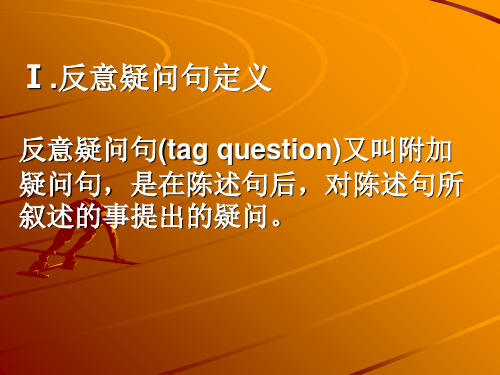
7.当陈述部分的主句是I think (expect, believe)等结构时,反 意疑问句的附加部分则往往与从 句中的主语和谓语动词保持对应 关系,但要注意否定的转移。 例如:
I think he’s funny, isn’t he? I don’t believe she likes my
You must have seen the film last week, didn’t you?
6. 当陈述部分是I am…时,反意疑 问句部分通常要用aren’t I;如陈述 句部分的主语是I am not时,反意疑 问句部分通常要用am I。 例如:
1)I am a teacher, aren’t I?
Ⅰ.反意疑问句定义
反意疑问句(tag question)又叫附加 疑问句,是在陈述句后,对陈述句所 叙述的事提出的疑问。
Ⅱ.基本结构:
陈述句+逗号+简短的一般疑问句?
遵循前肯定后否定前否后肯式的原则
①前肯后否式。例如:
You are all students, aren’t you﹖
②前否后肯式。例如:
Let’s have a rest, shall we? 以let us开头的祈使句,不包括 说话人在内,因此反意疑问句的 附加部分用will you。例如:
Let us stop now, will you?
Ⅳ. 反意疑问句的回答 “ 根据事实回答”
对反意疑问句的回答,无论问题的提法如何,如果 事实是肯定的,就用yes,事实是否定的,就要用no。 要特别注意陈述句部分是否定结构,反意疑问句部分 用肯定式提问时,回答yes或no与汉语正好相反。这 种省略回答的yes要译成“不”,no要译成“是”。
现在完成时的反义疑问句
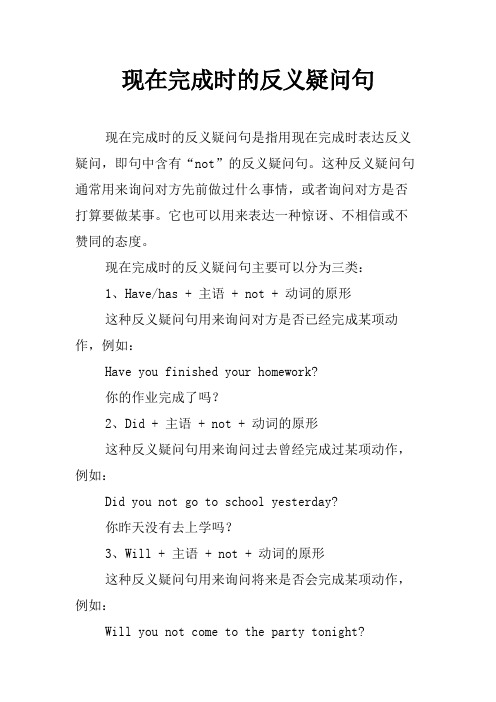
现在完成时的反义疑问句
现在完成时的反义疑问句是指用现在完成时表达反义疑问,即句中含有“not”的反义疑问句。
这种反义疑问句通常用来询问对方先前做过什么事情,或者询问对方是否打算要做某事。
它也可以用来表达一种惊讶、不相信或不赞同的态度。
现在完成时的反义疑问句主要可以分为三类:
1、Have/has + 主语 + not + 动词的原形
这种反义疑问句用来询问对方是否已经完成某项动作,例如:
Have you finished your homework?
你的作业完成了吗?
2、Did + 主语 + not + 动词的原形
这种反义疑问句用来询问过去曾经完成过某项动作,例如:
Did you not go to school yesterday?
你昨天没有去上学吗?
3、Will + 主语 + not + 动词的原形
这种反义疑问句用来询问将来是否会完成某项动作,例如:
Will you not come to the party tonight?
你今晚不会来参加聚会吗?
现在完成时的反义疑问句也可以用来表达一种惊讶、不相信或不赞同的态度。
例如:
You haven't done your homework yet?
你还没做作业?
此外,现在完成时的反义疑问句也可以用来强调某事物,以强调某事物的重要性。
例如:
Have you ever seen such a beautiful city?
你有没有见过这么美的城市?
总之,现在完成时的反义疑问句是一种有效的表达方式,既可以用来询问对方先前做过什么事情,也可以用来表达一种惊讶、不相信或不赞同的态度,从而强调某事物的重要性。
初中英语反意疑问句的知识点
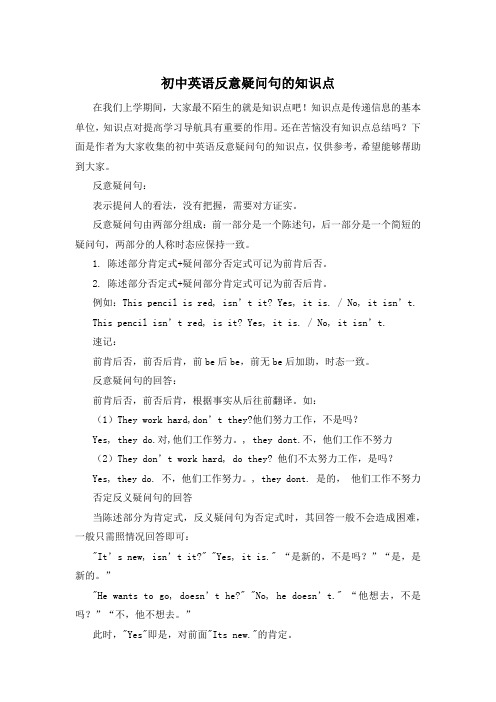
初中英语反意疑问句的知识点在我们上学期间,大家最不陌生的就是知识点吧!知识点是传递信息的基本单位,知识点对提高学习导航具有重要的作用。
还在苦恼没有知识点总结吗?下面是作者为大家收集的初中英语反意疑问句的知识点,仅供参考,希望能够帮助到大家。
反意疑问句:表示提问人的看法,没有把握,需要对方证实。
反意疑问句由两部分组成:前一部分是一个陈述句,后一部分是一个简短的疑问句,两部分的人称时态应保持一致。
1. 陈述部分肯定式+疑问部分否定式可记为前肯后否。
2. 陈述部分否定式+疑问部分肯定式可记为前否后肯。
例如:This pencil is red, isn’t it? Yes, it is. / No, it isn’t.This pencil isn’t red, is it? Yes, it is. / No, it isn’t.速记:前肯后否,前否后肯,前be后be,前无be后加助,时态一致。
反意疑问句的回答:前肯后否,前否后肯,根据事实从后往前翻译。
如:(1)They work hard,don’t they?他们努力工作,不是吗?Yes, they do.对,他们工作努力。
, they dont.不,他们工作不努力(2)They don’t work hard, do they? 他们不太努力工作,是吗?Yes, they do. 不,他们工作努力。
, they dont. 是的,他们工作不努力否定反义疑问句的回答当陈述部分为肯定式,反义疑问句为否定式时,其回答一般不会造成困难,一般只需照情况回答即可:"It’s new, isn’t it?" "Yes, it is." “是新的,不是吗?”“是,是新的。
”"He wants to go, doesn’t he?" "No, he doesn’t." “他想去,不是吗?”“不,他不想去。
初二现在完成时、反义疑问句、过去进行时、不定式专题练习
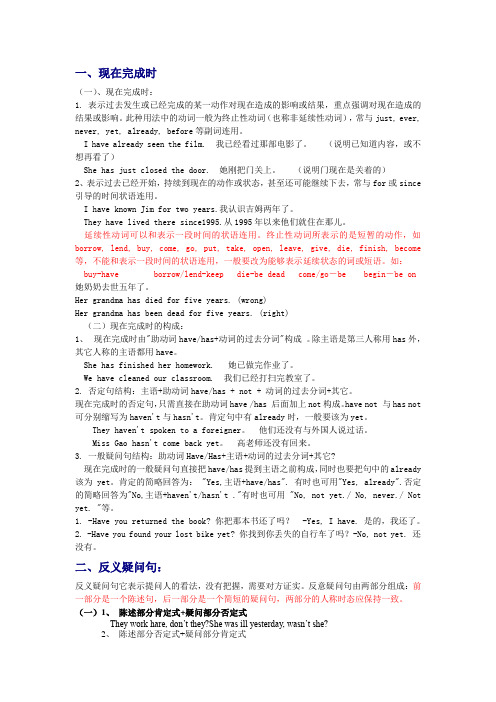
一、现在完成时(一)、现在完成时:1. 表示过去发生或已经完成的某一动作对现在造成的影响或结果,重点强调对现在造成的结果或影响。
此种用法中的动词一般为终止性动词(也称非延续性动词),常与just, ever, never, yet, already, before等副词连用。
I have already seen the film. 我已经看过那部电影了。
(说明已知道内容,或不想再看了)She has just closed the door. 她刚把门关上。
(说明门现在是关着的)2、表示过去已经开始,持续到现在的动作或状态,甚至还可能继续下去,常与for或since 引导的时间状语连用。
I have known Jim for two years.我认识吉姆两年了。
They have lived there since1995.从1995年以来他们就住在那儿。
延续性动词可以和表示一段时间的状语连用。
终止性动词所表示的是短暂的动作,如borrow, lend, buy, come, go, put, take, open, leave, give, die, finish, become 等,不能和表示一段时间的状语连用,一般要改为能够表示延续状态的词或短语。
如:buy-have borrow/lend-keep die-be dead come/go-be begin-be on 她奶奶去世五年了。
Her grandma has died for five years. (wrong)Her grandma has been dead for five years. (right)(二)现在完成时的构成:1、现在完成时由"助动词have/has+动词的过去分词"构成。
除主语是第三人称用has外,其它人称的主语都用have。
She has finished her homework. 她已做完作业了。
初中英语反义疑问句的用法归纳

初一反义疑问句【反义疑问句】〔一〕概念:反意疑问句是由陈述句和附在其后的附加疑问句组成。
其中附加疑问句是对陈述句所说的事实或观点提出疑问,起证实作用,一般用于证实说话者所说的事实或观点。
〔二〕要点注意:1、反意疑问句前后两局部谓语应是:“肯定陈述+否认疑问〞或“否认陈述+肯定疑问〞。
2、简单问句如果是否认式:not应与be,do,will等系动词、助动词、情态动词缩写。
3、简单问句的主语不用名词,应用人称代词。
4、陈述局部含“too...to〞时,是否认句。
〔三〕用法:1) 陈述局部I am时,疑问局部要用aren't I.I'm as tall as your sister,aren't I" 〔我和你姐姐一样高,对吗?〕2) 陈述局部用no, nothing, nobody, never, few, little, seldom, hardly等否认含义的词时,疑问局部用肯定含义。
如:The old man made no answer, did he"Jim is never late for school, is he"3) 陈述局部有情态动词have to +v. (had to + v.),疑问局部常用don't +主语〔didn't +主语〕。
We have to get there at eight tomorrow, don't we"used to,疑问局部用didn't +主语或usedn't +主语。
He used to take pictures there, didn't he" / usedn't he"had better〔最好〕+ v. 疑问句局部用hadn't you"You'd better read it by yourself, hadn't you"4) 陈述局部有would rather〔宁可、宁愿〕+v.,疑问局部多用wouldn't +主语。
反义疑问句讲解

•6. 当陈述部分有never,seldom(很少), hardly(几乎不),few,little,nothing(没有) 等否定意义的词时,后面的反意疑问句则为肯 定形式
1.They have never visited his home, have they ?
2.There are few apples in the basket ,are there ?
let
当为”let us”时 当为”let’s”时
疑问句为“will you” 前五后四 疑问句为“shall we “ 前四后五
1.Let’s go to park, Shall we ?
前四
后五
2.Let us do homework. 前五
Will you ? 后四
回答
不管肯定否定,只抓信息点,是否吻合。如实回答
反义疑问句
Grammar: 反意疑问句
一、定义: 当我们陈述了一个事实,而又不是很有把握,就可以 在陈述句后加一个简短问句,称为反意疑问句。 例:
1. She is a student, isn’t she? 2. We speak Chinese, don’t we?
二、结构:
结构一: 前肯,+ 后否 eg. She is a student, isn’t she? 结构二: 前否,+ 后肯 eg. She isn’t a student, is she?
3
4
5
找be动词,是is,则 后半句用isn’t
isn’t she ?
Be动词
1.It’s a nice day ,
Isn’t it ?
2.The Greens were at home last night ,
现在完成时反意疑问句
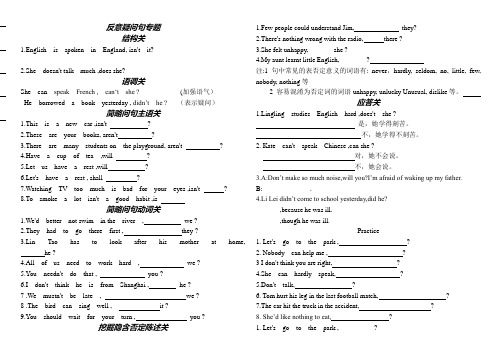
反意疑问句专题结构关1.English is spoken in England, isn't it?2.She doesn't talk much ,does she?语调关She can speak French , can‘t she ?(加强语气)He borrowed a book yesterday , didn’t he ? (表示疑问)简略问句主语关1.This is a new car ,isn't ?2.These are your books, aren't ?3.There are many students on the playground, aren't ?4.Have a cup of tea ,will ?5.Let us have a rest ,will ?6.Let's have a rest , shall ?7.Watching TV too much is bad for your eyes ,isn't ?8.To smoke a lot isn't a good habit ,is简略问句动词关1.We'd better not swim in the river , we ?2.They had to go there first , they ?3.Lin Tao has to look after his mother at home, _______he ?4.All of us need to work hard , we ?5.You needn't do that , you ?6.I don't think he is from Shanghai , he ?7 .We mustn't be late , we ?8 .The bird can sing well , it ?9.You should wait for your turn , you ?挖掘隐含否定陈述关1.Few people could understand Jim, they?2.There's nothing wrong with the radio, there ?3.She felt unhappy,_______ she ?4.My aunt learnt little English,________?注:1 句中常见的表否定意义的词语有: never,hardly, seldom, no, little, few, nobody, nothing等2 容易混淆为否定词的词语unhappy, unlucky Unusual, dislike等。
英语反义疑问句的用法归纳总结
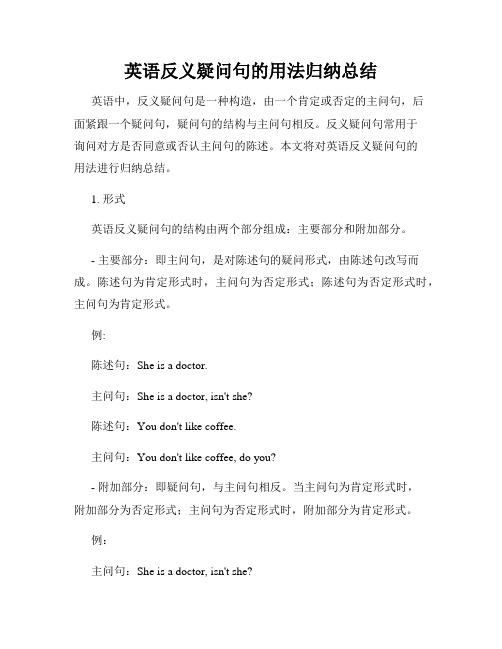
英语反义疑问句的用法归纳总结英语中,反义疑问句是一种构造,由一个肯定或否定的主问句,后面紧跟一个疑问句,疑问句的结构与主问句相反。
反义疑问句常用于询问对方是否同意或否认主问句的陈述。
本文将对英语反义疑问句的用法进行归纳总结。
1. 形式英语反义疑问句的结构由两个部分组成:主要部分和附加部分。
- 主要部分:即主问句,是对陈述句的疑问形式,由陈述句改写而成。
陈述句为肯定形式时,主问句为否定形式;陈述句为否定形式时,主问句为肯定形式。
例:陈述句:She is a doctor.主问句:She is a doctor, isn't she?陈述句:You don't like coffee.主问句:You don't like coffee, do you?- 附加部分:即疑问句,与主问句相反。
当主问句为肯定形式时,附加部分为否定形式;主问句为否定形式时,附加部分为肯定形式。
例:主问句:She is a doctor, isn't she?附加部分:isn't she?主问句:You don't like coffee, do you?附加部分:do you?2. 陈述句的时态和人称对反义疑问句的影响陈述句的时态和人称会影响反义疑问句的构造和回答方式。
- 一般现在时:陈述句为一般现在时时,主问句和附加部分使用助动词do/does。
例:陈述句:He likes ice cream.主问句:He likes ice cream, doesn't he?- 现在进行时:陈述句为现在进行时时,主问句和附加部分使用助动词be例:陈述句:They are playing soccer.主问句:They are playing soccer, aren't they?- 一般过去时:陈述句为一般过去时,主问句和附加部分使用助动词did例:陈述句:She went to the store.主问句:She went to the store, didn't she?- 现在完成时:陈述句为现在完成时,主问句和附加部分使用助动词have/has例:陈述句:They have finished their homework.主问句:They have finished their homework, haven't they?3. 注意事项- 主要部分和附加部分的人称要保持一致。
英语学习总结资料现在完成时及反意疑问句
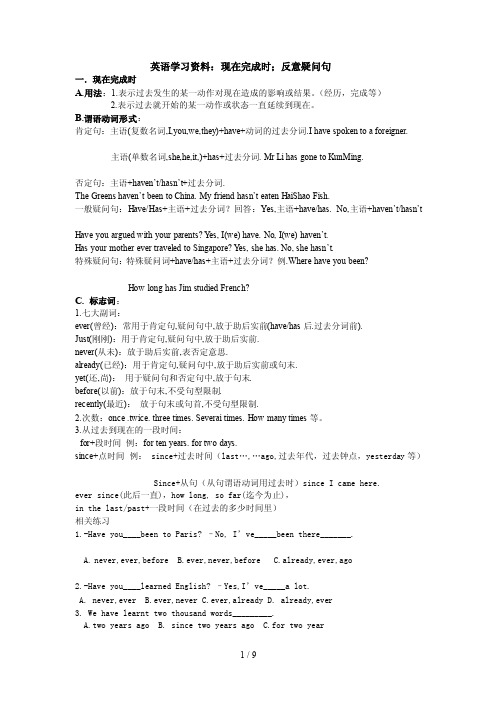
英语学习资料:现在完成时;反意疑问句一.现在完成时A.用法:1.表示过去发生的某一动作对现在造成的影响或结果。
(经历,完成等)2.表示过去就开始的某一动作或状态一直延续到现在。
B.谓语动词形式:肯定句:主语(复数名词,I,you,we,they)+have+动词的过去分词.I have spoken to a foreigner.主语(单数名词,she,he,it,)+has+过去分词. Mr Li has gone to KunMing.否定句:主语+haven’t/hasn’t+过去分词.The Greens haven’t been to China. My friend has n’t eaten HaiShao Fish.一般疑问句:Have/Has+主语+过去分词?回答:Yes,主语+have/has. No,主语+haven’t/hasn’tHave you argued with your parents? Y es, I(we) have. No, I(we) haven’t.Has your mother ever traveled to Singapore? Y es, she has. No, she hasn’t.特殊疑问句:特殊疑问词+have/has+主语+过去分词?例.Where have you been?How long has Jim studied French?C.标志词:1.七大副词:ever(曾经):常用于肯定句,疑问句中,放于助后实前(have/has后.过去分词前).Just(刚刚):用于肯定句,疑问句中,放于助后实前.never(从未):放于助后实前,表否定意思.already(已经):用于肯定句,疑问句中,放于助后实前或句末.yet(还,尚):用于疑问句和否定句中,放于句末.before(以前):放于句末,不受句型限制.recently(最近):放于句末或句首,不受句型限制.2.次数:once .twice. three times. Severai times. How many times等。
小升初英语培优第7讲:反义疑问句讲解(教师版)含答案
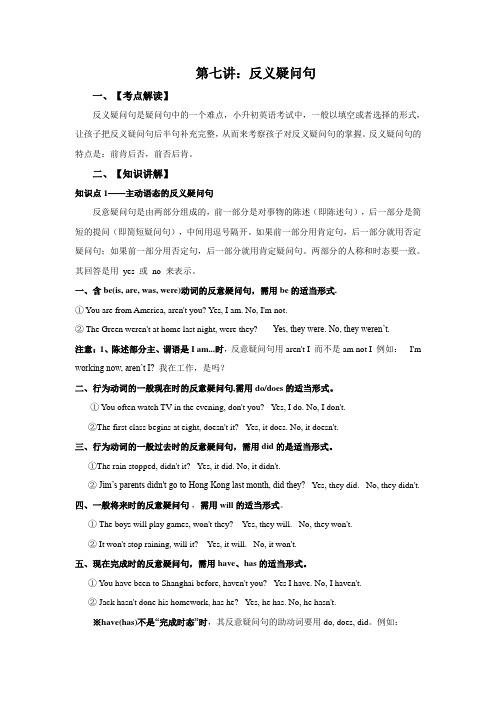
第七讲:反义疑问句一、【考点解读】反义疑问句是疑问句中的一个难点,小升初英语考试中,一般以填空或者选择的形式,让孩子把反义疑问句后半句补充完整,从而来考察孩子对反义疑问句的掌握。
反义疑问句的特点是:前肯后否,前否后肯。
二、【知识讲解】知识点1——主动语态的反义疑问句反意疑问句是由两部分组成的,前一部分是对事物的陈述(即陈述句),后一部分是简短的提问(即简短疑问句),中间用逗号隔开。
如果前一部分用肯定句,后一部分就用否定疑问句;如果前一部分用否定句,后一部分就用肯定疑问句。
两部分的人称和时态要一致。
其回答是用yes 或no 来表示。
一、含be(is, are, was, were)动词的反意疑问句,需用be的适当形式.① You are from America, aren't you? Yes, I am. No, I'm not.② The Green weren't at home last night, were they? Yes, they were. No, they weren’t.注意:1、陈述部分主、谓语是I am...时,反意疑问句用aren't I 而不是am not I 例如:I'm working now, aren’t I? 我在工作,是吗?二、行为动词的一般现在时的反意疑问句,需用do/does的适当形式。
① You often watch TV in the evening, don't you? Yes, I do. No, I don't.②The first class begins at eight, doesn't it? Yes, it does. No, it doesn't.三、行为动词的一般过去时的反意疑问句,需用did的是适当形式。
①The rain stopped, didn't it? Yes, it did. No, it didn't.② Jim’s parents didn't go to Hong Kong last month, did they? Yes, they did. No, they didn't.四、一般将来时的反意疑问句,需用will的适当形式。
have现在完成时的反义疑问句 -回复
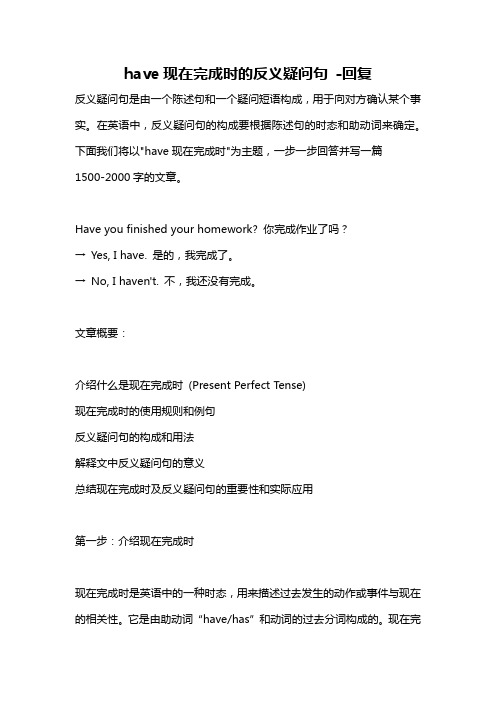
have现在完成时的反义疑问句-回复反义疑问句是由一个陈述句和一个疑问短语构成,用于向对方确认某个事实。
在英语中,反义疑问句的构成要根据陈述句的时态和助动词来确定。
下面我们将以"have现在完成时"为主题,一步一步回答并写一篇1500-2000字的文章。
Have you finished your homework? 你完成作业了吗?→Yes, I have. 是的,我完成了。
→No, I haven't. 不,我还没有完成。
文章概要:介绍什么是现在完成时(Present Perfect Tense)现在完成时的使用规则和例句反义疑问句的构成和用法解释文中反义疑问句的意义总结现在完成时及反义疑问句的重要性和实际应用第一步:介绍现在完成时现在完成时是英语中的一种时态,用来描述过去发生的动作或事件与现在的相关性。
它是由助动词“have/has”和动词的过去分词构成的。
现在完成时的使用可以表示过去的经历、状态、结果或某件事情对现在造成的影响。
例如:- I have been to Paris.(我去过巴黎。
)- They have lived here for 10 years.(他们在这里住了10年了。
)- She has just finished her presentation.(她刚刚完成了她的报告。
)第二步:现在完成时的使用规则和例句1. 现在完成时常与时间状语连用,如:already(已经)、yet(还)、just(刚刚)等。
- Have you finished your work yet?(你完成工作了吗?)- Yes, I have already finished it.(是的,我已经完成了。
)2. 现在完成时也可以用来表达过去的经验、经历或成就。
- She has climbed Mount Everest twice.(她已经两次攀登珠穆朗玛峰。
)3. 另外,现在完成时也可用于事件还在进行中,具有非限定性,有时翻译成汉语会带有"还/仍然"的意思。
反义疑问句(25张PPT)初中英语专项复习课件

【典例1】John had a short walk after lunch, _______?
A. did he
B. didn't he
C. had he
D. hadn't he
考查反义疑问句。反义疑问句遵循的原则为“前肯,后否;前否,后 肯”,得出疑问句部分为否定形式。陈述句部分为一般过去时,需用 助动词did来反问,故答案选B。
No, she hasn’t.
易错点2
常见时态的反义疑问句
一 般 过 去 时
She wasn’t at home, _w_a_s_s_h_e_? No, she wasn’t.
易错点2
常见时态的反义疑问句
一 般 过 去 时
They weren’t in the park last Sunday, _w_e_r_e_t_h_e_y_?
前肯 前否
后否 后肯
“是吗?” “是不是?” “这是真的吗?” “你同意吗?”
注意
附加疑问句= be、助动词、情态动词+人称代词主格
易错点1
反义疑问句的回答
Yes, 主语 + be动词/情态动词/助动词 No,主语 + be动词/情态动词/助动词 + not
易错点2
常见时态的反义疑问句
一 般 现 在 时
反义疑问句的特殊用法 祈使句的反义疑问句
反义疑问句的特殊用法
1
2
3
陈述句部分含 有否定意义的 词。
陈述部分主语
陈述部分是I am
或 I’m 。
是this, that ,
these, those时。 Nhomakorabea反义疑问句的特殊用法 1
反义疑问句
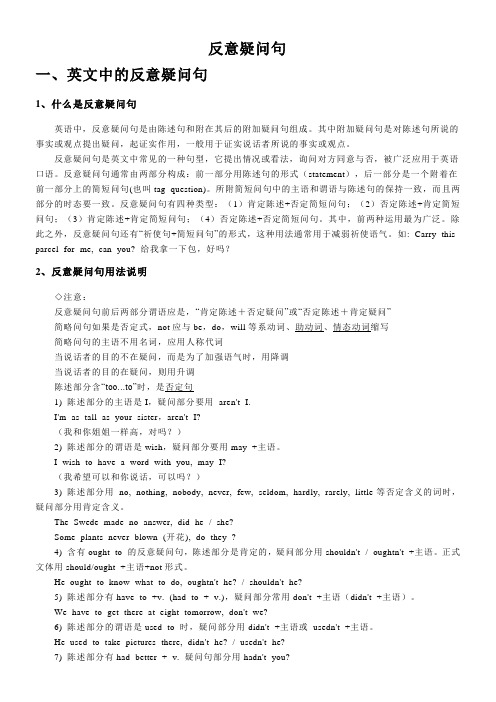
反意疑问句一、英文中的反意疑问句1、什么是反意疑问句英语中,反意疑问句是由陈述句和附在其后的附加疑问句组成。
其中附加疑问句是对陈述句所说的事实或观点提出疑问,起证实作用,一般用于证实说话者所说的事实或观点。
反意疑问句是英文中常见的一种句型,它提出情况或看法,询问对方同意与否,被广泛应用于英语口语。
反意疑问句通常由两部分构成:前一部分用陈述句的形式(statement),后一部分是一个附着在前一部分上的简短问句(也叫tag question)。
所附简短问句中的主语和谓语与陈述句的保持一致,而且两部分的时态要一致。
反意疑问句有四种类型:(1)肯定陈述+否定简短问句;(2)否定陈述+肯定简短问句;(3)肯定陈述+肯定简短问句;(4)否定陈述+否定简短问句。
其中,前两种运用最为广泛。
除此之外,反意疑问句还有“祈使句+简短问句”的形式,这种用法通常用于减弱祈使语气。
如: Carry this parcel for me, can you? 给我拿一下包,好吗?2、反意疑问句用法说明◇注意:反意疑问句前后两部分谓语应是,“肯定陈述+否定疑问”或“否定陈述+肯定疑问”简略问句如果是否定式,not应与be,do,will等系动词、助动词、情态动词缩写简略问句的主语不用名词,应用人称代词当说话者的目的不在疑问,而是为了加强语气时,用降调当说话者的目的在疑问,则用升调陈述部分含“too...to”时,是否定句1) 陈述部分的主语是I,疑问部分要用aren't I.I'm as tall as your sister,aren't I?(我和你姐姐一样高,对吗?)2) 陈述部分的谓语是wish,疑问部分要用may +主语。
I wish to have a word with you, may I?(我希望可以和你说话,可以吗?)3) 陈述部分用no, nothing, nobody, never, few, seldom, hardly, rarely, little等否定含义的词时,疑问部分用肯定含义。
- 1、下载文档前请自行甄别文档内容的完整性,平台不提供额外的编辑、内容补充、找答案等附加服务。
- 2、"仅部分预览"的文档,不可在线预览部分如存在完整性等问题,可反馈申请退款(可完整预览的文档不适用该条件!)。
- 3、如文档侵犯您的权益,请联系客服反馈,我们会尽快为您处理(人工客服工作时间:9:00-18:30)。
反意疑问句讲解1. 前肯(定)+后否(定)?一、反意疑问句中问句部分的动词在时态上应和陈述部分的时态一致。
如:1。
You can do it, can’t you?2.They are very late for the meeting, aren’t they?3.He has supper at home every day, doesn’t he? (不能用hasn’t he?)4.They have known the matter, haven’t they?5.They wi ll go to town soon, won’t they?6.He worked very hard, did n’t he?他过去工作很努力,对吧?Yes, he did. No, he didn’t.是的,他很努力。
不,他工作不努力。
二.前否(定)+后肯(定)?反意疑问句的陈述部分含有not no,nothing,no one, never, hardly, little, few,seldom等表否定的词。
变反意疑问句时要用前否(定)+后肯(定)?如:1.He isn’t playing football now, is he?2.She never tells a lie, does she?(不用doesn’t she?)3.I have few books, do I?4, He was seldom late, was he?(不用wasn’t he?)5.There is little water in the bag, is there?6.Nothing is in the room, is it?房间里什么也没有,是吗?7,The boys and girls have never been to Chongqing,have they? 孩子们从未去过重庆,对吧?三.由un-, im-, in-, dis-, 等否定意义的前缀构成的词语时,陈述部分要视为肯定含义,问句部分用否定形式。
如:①Your father is unhappy, isn’t he?(不能用is he?)②The man is dishonest, isn’t he? (不能用is he?)③It is impossible to learn English without rememberingmore words, isn’t it?(不能用is it ?)四.反意疑问句的陈述部分为I am…时,问句部分习惯上用aren’t I?表示。
如:I am a very honest man, aren’t I?五.反意疑问句的陈述部分为I(We) think(believe, suppose, consider) + that从句时,问句部分的动词及主语与that 从句内的动词和主语保持一致。
如:①I think that he has done his best, hasn’t he?②We think that English is very useful, isn’t it? (不用don’twe?)八.反意疑问句的陈述部分为I(We) don’t think(believe, suppose, consider)+ that从句时,从句为否定意义,问句部分的动词和主语仍与that从句保持一致且用肯定式。
如:①I don’t think that you ca n do it, can you? (不用do I?)②We don’t believe that the news is true, is it? (不用dowe?)九.反意疑问句的陈述部分为非第一人称主语+ think(believe, suppose, consider) + that从句时,问句部分的动词和主语与陈述部分的主句动词和主语保持一致。
如:①They all think that English is very important, don’t they? (不用isn’t it?)②He didn’t think that the news was true, did he? (不用wasn’t/ was it?)十、反意疑问句的陈述部分为主语+said( told, reported,asked……) + that从句时,问句部分的动词和主语与陈述部分的主句动词和主语保持一致。
如:①They said that you had finished your work, didn’t they?(不用hadn’t you)②Kate told you that she would go there, didn’t she? (不用wouldn’t she?)十一、陈述部分的主语为不定代词something, anything, nothing, everything时,问句部分的主语用it。
如:①Something is wrong with the computer, isn’t it?②Nothing has happened to them, has it?十二、陈述部分的主语为不定代词somebody(someone), anybody(anyone), nobody(no one), everybody(everyone)时,问句部分的主语用he或they,这时问句动词的数应和he 或they一致。
如:①Someone has taken the seat, hasn’t he?③Everyone has done their best in the game, haven’tthey?十三。
This is a pen , isn’t it?(不能说isn’t this ?)That is a book,, isn’t it ? (不能说isn’t that ?)These /Those are maps, aren’t they ?(不能说aren’t these /those?)十四、陈述部分为Let us……时,问句部分习惯上用will you?形式。
如:Let us stop to rest, will you?十五、陈述部分为Let’s……时,问句部分习惯上用shall we?形式。
如:Let’s go home together, shall we?十六、陈述部分用上述情况以外的祈使句时,问句部分一般用will you?形式表示请求,用won’t you?形式表示委婉请求或邀请。
如:①Do sit down, won’t you?/ will you?Please open the window, will you?(won’t you?)十七、陈述部分为否定祈使句时,问句部分一般用will you?形式。
如:Don’t make any noise, will you?十八、陈述部分为There (Here) + be + 主语时,问句部分用动词+there(here)?形式。
如:①There are two cakes on the plate, aren’t there?②Here is a story about Mark Twain, isn’t here?十九、陈述部分用had better +原形动词表示建议时,问句部分用hadn’t +主语?形式。
①You’d better tell him about the matter, hadn’t you?②We had better do it by ourselves, hadn’t we?二十、陈述部分用used to +主语时,问句部分用didn’t + 主语?或usedn’t +主语?形式。
如:①He used to live in the country, didn’t he?/usedn’t he?②They used to be good friends, didn’t they?/usedn’t they? 二十一、陈述部分的主语为动名词或不定式时,问句的主语用it代替。
如:①To do one good deed is easy for a person, isn't it?②Skating is your favorite sport, isn't it?二十二。
反义疑问句的回答1.The door is open now, isn’t it ? Yes ,it is.门现在是开着的,是吗? 是的,是开着的。
2.The girl hasn’t been to Chongqing ,has she ?Yes, she has./ No, she hasn’t.这个女孩没来过重庆,对吗/是吗?不,来过。
/ 是的,没来过3.He has little money, _____ _____?他几乎没钱了,对吗? Yes, _______ _________.不,他有钱。
______,_______ _______ . 是的,他几乎没钱了。
初中英语现在完成时的用法及专项练习have(has)+过去分词1.现在完成时用来表示现在之前已发生活或完成的动作或状态,但其结果却和现在有联系,也就是说,动作或状态发生在过去但它的影响现在还存在.I have lost my wallet.(含义是:现在我没有钱花了.)Jane has laid the table.(含义是:已可以吃饭了.)Michael has been ill.(含义是:现在仍然很虚弱)He has returned from abroad. (含义是:现在已在此地) 2. 现在完成时可以用来表示发生在过去某一时刻的,持续到现在的情况,常与for ,since连用.Mary has been ill for three days.I have lived here since 1998.3. 现在完成时往往同表示不确定的过去时间状语连用,如already, yet, just, before, recently, lately等:He has already obtained a scholarship.I haven't seen much of him recently (lately).We have seen that film before.Have they found the missing child yet4. 现在完成时常常与表示频度的时间状语连用,如often, sometimes, ever, never, twice, on several occasion等: Have you ever been to BeijingI have never heard Bunny say anything against her.I have used this pen only three times. It is still good. George has met that gentleman on several occasions.5. 现在完成时还往往可以同包括现在时间在内的时间状语连用,如now, up to these few days/weeks/months/years, this morning/week/month/year, now, just, today, up to present, so far等:Peter has written six papers so far.Man has now learned to release energy from the nucleus of the atom.There has bee too much rain in San Francisco this year. The friendly relations and cooperation between our two countries have been enhanced in the past few years.Up to the present everything has been successful.6. 现在完成时表示现在之前业已完成的动作,虽然其效果或影响仍然存在但已不再继续,但是有一些现在完成时的句子,在后面加上for+一段时间,则现在完成时的动作就表示延续性.Thomas has studied Russian. (现在不再学俄语) Thomas has studied Russian for three years. (=Thomas began to study Russian three years ago, and is still studying it now.(同第2点用法第一个例句)7. 现在完成时还可以用来表示过去的一个时间到现在这段时间内重复发生的动作.We have had four texts this semester.===================现在完成时的“完成用法”和“未完成用法”1.现在完成时的"完成用法"现在完成时的"完成用法"指的是动作发生在过去某一时刻并已结束,但该动作对现在产生了影响,与现在情况具有因果关系。
